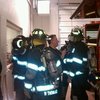‘You can’t preserve what you don’t know’ says Kowlowitz
As newcomers move to Voorheesville and New Scotland, Alan Kowlowitz hopes they will embrace their heritage, not as a matter of genetics, a love of place handed down through family, but rather like the love that ties a marriage together.
He cites a tour of Voorheesville given by Dennis Ulion, focusing on the community of Italian immigrants that settled in Voorheesville several generations ago — their history now intertwined with the village’s.
Kowlowitz himself was raised in Queens — the son of a fur worker and dental secretary — whose best subject was always history.
Throughout his life, he has been a constant reader of history. He prefers academic work over popular history books, in which the errors rankle him.
For their honeymoon, he and his wife visited historic Williamsburg and Monticello.
His wife’s family has deep roots in western New York, in Chautauqua. Kowlowitz plays his bagpipes at their family reunions.
New Scotland is growing at a faster rate than any other municipality in Albany County, with a 5.8 percent increase in population over the last decade, according to the recently released federal census data.
Kowlowitz sees an irony in people moving to New Scotland because it’s a beautiful town and then having the development pressure erode what drew them to town in the first place.
“You can’t preserve what you don’t know,” says Kowlowitz in this week’s podcast at www.AltamontEnterprise.com/podcasts.
Kowlowitz chairs the joint village and town Historic Preservation Commission. Voorheesville and New Scotland this summer were awarded a $10,000 grant from the Preservation League of New York State to fund a cultural resource survey for the village and the hamlets of New Salem and New Scotland.
About 300 buildings, each at least 50 years old, will be photographed, researched, and mapped with the information uploaded to the state’s Cultural Resources Information System.
“You inherit the history of where you live … It becomes part of your history even though you may not be raised here,” said Kowlowitz.
After he left Queens, earning an undergraduate degree in political science and later a master’s degree in history and sociology, Kowlowitz eventually went to work, in 1979, for the New York State Archives.
Much of his early work focused on Court of Chancery records when, before 1847, New York had a separate system from common law to deal with matters such as trusts and divorces.
Kowlowitz went on to help develop the first electronic records program for the state archives and then moved into the field of information security.
After he became active in the New Scotland Historical Association, Kowlowitz invited John Scherer, a Voorheesville native and municipal historian for Clifton Park, to speak to the association.
Scherer’s talk, about how Clifton Park, under a lot of development pressure, had come up with a voluntary mechanism to preserve historic sites, struck Kowlowitz as a good approach for Voorheesville and New Scotland, leading to legislation that formed the commission he now heads.
In applying for the Preservation League grant, Kowlowitz said the original idea was to survey the entire town but those costs would be “astronomical” so the focus was on parts of town under development pressure, places where historic structures may be in danger.
“The village of Voorheesville has a good sense of itself as a railroad town,” Kowlowitz said, but a hamlet like New Salem is underappreciated.
With his background studying social history, Kowlowitz sees New Salem as a gateway to historic Helderberg vacations, which can be linked to modern leisure activities just as the rail trail can be a new engine for economic development.
He notes that both the village and town have components of historic preservation and appropriate economic and leisure development in their master plans.
Kowlowitz also sees historic preservation as dovetailing with the open-space movement and cites the recent preservation, with conservation easements, of both the historic Bender Melon Farm and Picard’s Grove in town.
Kowlowitz recalled the razing of the iconic Severson House to make way for needed senior housing. “Everyone bemoaned the fact it was destroyed ….,” he said, “Nobody could do anything about it.”
He hopes the current initiative will focus public awareness of historic buildings in town before it is too late.
— Melissa Hale-Spencer



